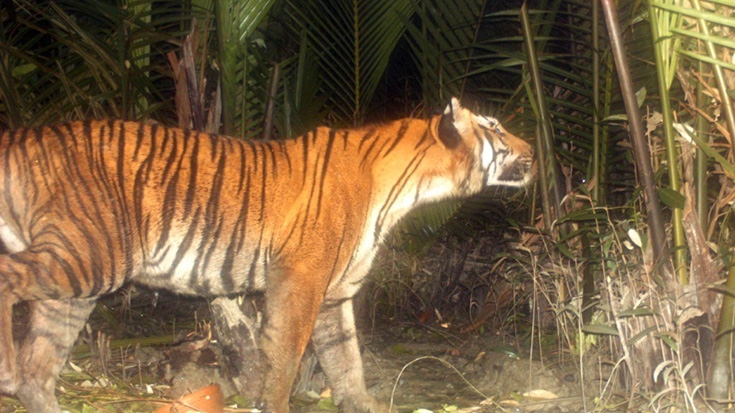South Asia is home to 13-15% of the world's biodiversity including some of the world’s most endangered species. The world’s tiger population has declined alarmingly, mainly due to poaching and the encroachment of tiger habitats. 65% of the 3,000 or so remaining wild tigers are found in Bangladesh, Bhutan, India and Nepal. With South Asia’s rich biodiversity, the region is a lucrative place for illegal wildlife trade. To help preserve the region's biodiversity, the Strengthening Regional Cooperation for Wildlife Protection in Asia (SRCWP) project helps countries tackle illegal wildlife trade.
Challenge
According to The Wildlife Trade Monitoring Network (TRAFFIC) report, the seizure of parts of more than 1,400 tigers across Asia in the last 13 years indicate an alarming rate of illegal trade of tiger parts. Illegal wildlife trade is largely controlled by criminal gangs who poach flagship species such as tigers and elephants in one country, store them in another, and then trade them outside of South Asia. No single country on its own can contain illegal wildlife trade, thus cross-border collaboration is required to stop poaching. This makes the control of the illegal trade of wildlife and wildlife parts a challenging multi-country responsibility.
Approach
The first World Bank regional project in South Asia, the Strengthening Regional Cooperation for Wildlife Protection in Asia (SRCWP) follows two-pronged approach: capacity building to address the illegal wildlife trade through regional cooperation, and habitat protection and management to promote regional conservation benefits and address human-wildlife conflict. The project assists participating governments in building or enhancing shared capacity, institutions, knowledge, and incentives to collaborate on tackling the illegal wildlife trade and other selected regional conservation threats to habitats.
The project has already led to some significant developments in Bangladesh, since its inception in 2011:
- Combating Wildlife Trafficking and Crime:
The project helped the Bangladesh Forest Department (BFD) to establish a Wildlife Crime Control Unit (WCCU) which is equipped with a forensics lab, a legal support arm, and a wildlife crime control group to implement the Bangladesh Wildlife (Conservation) Act 2012. The WCCU has a 24-hour hotline for reporting of illegal wildlife trafficking and other wildlife related crimes.
The WCCU coordinates with other agencies including the Rapid Action Battalion (RAB), Border Guard, Coast Guard, Customs, Police, and Ministry of Foreign Affairs to tackle wildlife crime within Bangladesh. The WCCU also collaborates with TRAFFIC, UNODC, INTERPOL, and the International Consortium on Combating Wildlife Crime (ICCWC) internationally to build synergies and to develop and implement tools for more effective enforcement of the wildlife trade and landscape based conservation. Bangladesh is the first South Asian country that is in the process of implementing the Wildlife and Forest Crime Analytic Toolkit developed by UNODC and ICCWC.
- Protection of Flagship Species & Protected Areas Management:
The Project is assisting the Bangladesh Forest Department in partnership with four universities, and six non-governmental institutions to implement 34 sub-projects, aimed to improve the management of protected areas and conservation of flagship species through a landscape approach. The endangered species addressed under these sub-projects include Bengal tigers, Elephants, Gharials, Langurs, Marine Turtles, Saltwater Crocodiles, Spoon-billed Sandpipers, Waterbirds, and White-rumped Vultures. Some of the sub-projects are addressing human-wildlife conflict through engagement with the local communities and civil society.
- Tiger Census:
Bangladesh is among the 13 tiger range countries where tigers still roam in the wild. It is important to have accurate estimation of the tiger population and density for formulating effective management plans for the Sundarbans. The project is supporting the census of Bengal tigers in Bangladesh's Sundarbans region through camera trapping method. The census using cameras would last from October 2013 to November 2014. Digital infrared camera with thermal and motion detecting sensors are being used for the census.
- Human-Elephant Conflict
The Elephant population is declining at an alarming rate due to habitat loss and fragmentation caused by illegal timber felling, encroachment for settlements and agriculture, unplanned road construction, and other challenges. Elephants move between Bangladesh and the neighboring forests of Arakan Yoma in Myanmar, and Assam, Meghalaya, Mizoram, and Tripura states in India. As their habitat gets destroyed and food sources become scarce, the incidence of human-elephant conflict (HEC) has increased, killing 47 elephants and 180 humans between 2003 to 2012. To mitigate human-elephant conflict, the project has mapped routes of elephant corridors and two major Human-Elephant conflict areas while a detailed study is ongoing for developing pilot projects for addressing HEC.
Project Results to Date
- Wildlife Crime Control Units established in the Forest Department headquarters in Dhaka and in seven divisional forest offices.
- The rescue of 5,253 wild animals and the arrest of 171 wildlife offenders between 2012 to April 2014
- Approval of the Wildlife Conservation and Security Act 2012 by the Bangladesh Parliament
- The Bangladesh Forest Department is conducting a census of Bengal tigers in the country and using the data for monitoring the size and density of the tiger population in the Bangladesh Sundarbans.
- Ongoing preparation of Protected Areas Management Plans
- 30 Bangladesh forestry department officials completed the certificate training course on wildlife management at the Wildlife Institute of India. In total, more than 800 forest department officials have received in-country training.
- The implementation of the National Tiger Recovery Plan is underway.
- Ongoing implementation of 34 subprojects on habitat improvement, eco-tourism development and human-wildlife conflict mitigation
Towards the Future
India has demonstrated its commitment to cooperate in regional wildlife conservation through a bilateral Memoranda of Understanding (MOU) relating to wildlife and ecosystems in cooperation with Bangladesh, Bhutan and Nepal and is expected to collaborate to further the project’s goals of protecting biodiversity in South Asia.


